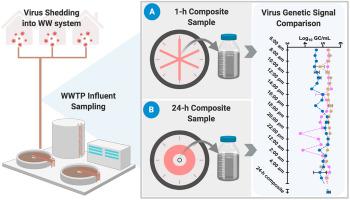Environmental Research ( IF 8.3 ) Pub Date : 2020-11-26 , DOI: 10.1016/j.envres.2020.110531 Warish Ahmed 1 , Aaron Bivins 2 , Paul M Bertsch 1 , Kyle Bibby 2 , Pradip Gyawali 3 , Samendra P Sherchan 4 , Stuart L Simpson 5 , Kevin V Thomas 6 , Rory Verhagen 6 , Masaaki Kitajima 7 , Jochen F Mueller 6 , Asja Korajkic 8

|
We monitored the density of fecal indicator viruses crAssphage and pepper mild mottle virus (PMMoV) and human pathogen adenovirus (HAdV) in influent from a wastewater treatment plant in Brisbane, Australia in 1-h and 24-h composite samples. Over three days of sampling, the mean concentration of crAssphage gene copies (GC)/mL in 24-h composite samples did not differ significantly (p = 0.72), while for PMMoV GC/mL (p value range: 0.0002-0.0321) and HAdV GC/mL (p value range: 0.72-0.92), significant differences in concentrations, were observed on one day of sampling compared to the other two. For all three viruses the variation observed in 1-h composite samples was greater than the variation observed in 24-h composite samples. For crAssphage, in 54.1% of 1-h composite samples, the concentration was less than that observed in 24-h composite samples; whereas for PMMoV and HAdV the concentration was less in 79.2% and 70.9% of 1-h composites, respectively, compared to the relevant 24-h composite. Similarly, the concentration of crAssphage DNA in 1-h compared to 24-h composite samples did not differ (p = 0.11) while the concentrations of PMMoV (p <0.0001) and HAdV (p <0.0001) in 1-h composites were significantly different from 24-h composites. These results suggest that 24-h composite samples offer increased analytical sensitivity and decreased variability compared to 1-h composite samples when monitoring wastewater, especially for pathogenic viruses with low infection rate within a community. Thus, for wastewater-based epidemiology applications, 24-h composite samples are less likely to produce false negative results and erroneous public health guidance.
中文翻译:

1 小时和 24 小时复合废水样品中指示剂和致病病毒的日内变异性:对基于废水的流行病学的影响
我们在 1 小时和 24 小时的复合样本中监测了澳大利亚布里斯班一家污水处理厂进水中的粪便指示病毒 crAssphage 和辣椒轻度斑驳病毒 (PMMoV) 和人类病原体腺病毒 (HAdV) 的密度。在三天的采样中,24 小时复合样本中 crAssphage 基因拷贝 (GC)/mL 的平均浓度没有显着差异 ( p = 0.72),而 PMMoV GC/mL ( p值范围:0.0002-0.0321) 和HAdV GC/mL ( p取值范围:0.72-0.92),浓度差异显着,与其他两天相比,在采样的一天观察到。对于所有三种病毒,在 1 小时复合样品中观察到的变异大于在 24 小时复合样品中观察到的变异。对于 crAssphage,在 54.1% 的 1 小时复合样品中,浓度低于 24 小时复合样品中观察到的浓度;而对于 PMMoV 和 HAdV,与相关的 24 小时复合材料相比,1 小时复合材料的浓度分别为 79.2% 和 70.9%。同样,与 24 小时复合样品相比,1 小时内 crAssphage DNA 的浓度没有差异 ( p = 0.11),而 PMMoV ( p <0.0001) 和 HAdV ( p<0.0001) 在 1 小时复合材料中与 24 小时复合材料显着不同。这些结果表明,在监测废水时,与 1 小时复合样品相比,24 小时复合样品提供更高的分析灵敏度和更低的变异性,特别是对于社区内感染率低的病原病毒。因此,对于基于废水的流行病学应用,24 小时复合样本不太可能产生假阴性结果和错误的公共卫生指导。



























 京公网安备 11010802027423号
京公网安备 11010802027423号